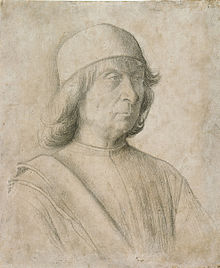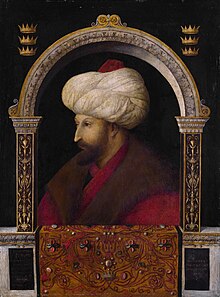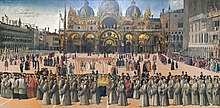User:Atian117/Gentile Bellini
Gentile Bellini[edit]
From Wikipedia, the free encyclopedia Jump to navigationJump to search
Gentile Bellini | |
|---|---|
| Gentile Bellini, Self-portrait, 1496. Kupferstichkabinett, Berlin (KdZ 5170) | |
| Born | c. 1429
|
| Died | 23 February 1507
|
| Resting place | Basilica di San Giovanni e Paolo |
| Known for | Painter, noted for portraits and paintings of Middle Eastern scenes |
| Notable work | Sultan Mehmed II and others |
Gentile Bellini (c. 1429 – 23 February 1507) was an Italian painter of the school of Venice. He came from Venice's leading family of painters, and at least in the early part of his career was more highly regarded than his brother Giovanni Bellini, the reverse of the case today. The brothers were close in age, but who was older is still uncertain.[1] From 1474 he was the official portrait artist for the Doges of Venice, and as well as his portraits he painted several very large subjects with multitudes of figures, especially for the Scuole Grandi of Venice and wealthy confraternities that were a prominent part of Venetian patrician social life.[2]
Contents[edit]
- 1Biography
- 2Paintings
- 3Bellini and the East
- 4Retirement years and legacy
- 5Selected works
- 6Notes
- 7References
- 8See also
- 9External links
Biography[edit][edit]


Gentile was born into the leading family of painters in Venice. His father Jacopo Bellini, was a Venetian pioneer in the use of oil paint as an artistic medium; his brother was Giovanni Bellini, and his brother-in-law Andrea Mantegna. Gentile's and Giovanni's exact birth date is uncertain and scholars have debated who is the older brother.[3] He was christened Gentile after Jacopo's master, Gentile da Fabriano, who was known for his Gothic style.[4] Gentile was taught painting in the workshop of his father. Although today Gentile is often seen in the shadow of his more famous family members, in his own time he was considered among the greatest living painters in Venice and had no shortage of commissions; his talent as a portraitist revealed itself at an early age. His renowned painting skills caused the Venetian senate to send him to Istanbul, when the Sultan requested a portraitist shortly after a peace treaty was established between the Venetians and the Turks in 1479.[5] When his father Jacopo Bellini died, Gentile was given his two albums. Gentile gave one album to the Ottoman Sultan Mehmed II and entrusted the other album to his brother Giovanni in his will.[4] Gentile died in 1501 and was given a great burial by his brother Giovanni in San Giovanni e Paolo.[6]
Paintings[edit][edit]


Gentile's earliest signed work is The Blessed Lorenzo Giustinian (1445), one of the oldest surviving oil paintings in Venice (now at the Accademia Museum). During the 1450s Bellini worked on a commission for the Scuola Grande di San Marco and painted in conjunction with his brother, Giovanni Bellini. From 1454 he was also the official portrait artist for the Doges of Venice, (for example, see image of the Doge Giovanni Mocenigo at right).[2]
Much of Gentile Bellini's surviving work consists of very large paintings for public buildings, including those for the Scuola Grande di San Giovanni Evangelista. Along with Lazzaro Bastiani, Vittore Carpaccio, Giovanni Mansueti, and Benedetto Rusconi, Bellini was one of the artists hired to paint the 10-painting narrative cycle known as The Miracles of the Relic of the Cross. The commission intended to celebrate the relic of the Holy Cross which the confraternity had received in 1369. Gentile's contributions include the Procession of the True Cross in Piazza San Marco, which dates from 1496, and the Miracle of the True Cross at the S. Lorenzo Bridge, dating from 1500 and featuring Gentile's self-portrait and that of his brother Giovanni.[2]
Unfortunately, most of Gentile's works have been destroyed in fires or by other means.[6]
Bellini and the East[edit][edit]
Venice was, at that time, a very important point in which cultures and trade bordered on the eastern Mediterranean Sea and provided gateways to Asia and Africa. In 1479, he was chosen by the government of Venice to work for Sultan Mehmed II in Istanbul. However, in addition to his work at the Ottoman Court, Gentile's work also responded to other aspects of the East, including the Byzantine Empire.
Istanbul[edit][edit]

In September 1479 Gentile was sent by the Venetian Senate to the new Ottoman capital Istanbul as part of the peace settlement between Venice and the Turks. The Senate thought about sending Giovanni Bellini, but due to his health, they were not sure if he would be able to withstand the voyage to Istanbul. Instead, Gentile was sent because the senate thought that he would paint just as well as his brother. [6] His role was not only as a visiting painter in an exotic locale but also as a cultural ambassador for Venice. This was important to Mehmed II because he was interested in the art and culture of Italy, and he attempted on several occasions to have himself portrayed by Italian artists. He was finally satisfied with Gentile, who is believed to have painted the portrait of Mehmed II now in the National Gallery, London, (but largely overpainted). The Sultan also challenged Gentile to paint himself. Gentile agreed to paint his portrait with a mirror. The self-portrait was shown to the Sultan and was so lifelike that he thought that there was some divine spirit within Gentile. Mehmed II wanted to keep him in Istanbul forever but it was forbidden by law. The admiration of Gentile was also shown when the Sultan told Gentile that he could demand whatever he wanted and it would be granted. Gentile asked for a letter of recommendation and a Signoria of Venice. The Sultan met the demands and dismissed Gentile with honorable gifts such as a chain that was equal in weight to 250 gold crowns.[6]
Gentile Bellini spent a total of one year and four months working for the Ottoman Court.[5] Subsequently, an Oriental flavor appears in several of his paintings, including the portrait of a Turkish artist and St. Mark Preaching at Alexandria (above). The last was completed by his brother, Giovanni Bellini.
According to Carlo Ridolfi (who was born 87 years after Bellini's death) in his 1648 history of the Venetian painters:[2]
Bellini made a painting of the head of John the Baptist on a charger, the saint being revered by the Turks as a prophet. When the picture was brought before the Sultan, he praised the skill exhibited there, but drew Gentile's attention nonetheless to an error, which was that the neck stretched out too far from the head, and as it appeared to him that Gentile appeared unconvinced, to enable him to see the natural effect, he had a slave brought to him and had his head chopped off, demonstrating to him how, once separated from the chest, the neck contracted. Gentile, fearful at such barbarities, immediately tried in every way to be released from his contract in case one day he himself should be the victim of such a joke.
This anecdote is likely apocryphal, as a similar story had been told by Seneca of Parrhasius, as well as of Michelangelo via a dubious source.
Upon his return, Gentile was welcomed by his brother Giovanni and the whole city for satisfying the Ottoman Ruler. The Doge and the Signoria received him well and decreed him 200 crowns a year for the rest of his life.[6]
Greece[edit][edit]

Queen Caterina Cornaro, c. 1500; Szépmüvészeti Múzeum, Budapest
Gentile responded to other aspects of the East, including the Byzantine Greek Empire, as well as Venice's other trading partners in North Africa and the Levant. Venice had a long-established relationship with the Eastern Mediterranean. Saint Mark, Venice's patron, was from the Egyptian city of Alexandria, and Venice's cultural and spiritual center – the basilica of San Marco – was built in his honor (and as his mausoleum) in the Greek Byzantine style. Although Constantinople fell to the Ottoman Turks in 1453, the Greek Byzantine world had a continuing impact upon Venetian art and culture as many Greek Christians fled Muslim rule. It was here that Gentile painted the portrait of Queen Caterina Cornaro of Cyprus (at right). This is counted as the second known portrait including the queen, which is now in the collection of the Szepmuveszeti Museum in Budapest.[2]
Date of Birth Debate[edit]
Gentile and Giovanni Bellini's exact birthdays are unknown, so experts have speculated who was the older brother and why. Some say that Giovanni is the older brother because the Venetian senate sent Gentile to Istanbul. After all, Giovanni was too old. However, in the will of Anna Bellini, Giovanni and Gentile's mother, only Gentile was mentioned and was given the drawing books of their father, Jacopo Bellini. Since only Gentile was mentioned in the will, that would indicate that Gentile was the older brother. Another argument for Gentile being older is that Giovanni was listed third, after Gentile and their father, on a lost altarpiece for the Gattamelata Chapel.
These examples call into question who was older, but also questions if Giovanni Bellini was born out of the marriage between Anna and Jacopo. If Giovanni was older, experts question why Gentile would receive the drawing books instead of Giovanni and why Giovanni was not mentioned in his mother's will. [1]
Retirement years and legacy[edit][edit]
Bellini's most important paintings, the monumental canvases in the Doge's Palace in Venice, were destroyed by fire in 1577. Only a few of his other works remain, namely the large narrative paintings The Procession in Piazza San Marco (above left) and The Preaching of Saint Mark in Alexandria (above right), produced in his final years. Little remains of Gentile's art from the 1470s and 1480s, except for the works made in Istanbul. Moreover, many workshop paintings and drawings have been assigned to Gentile Bellini. This has had the unfortunate consequence of confirming his reputation as an awkward artist, especially in comparison with his beloved brother Giovanni. Gentile's fall from popular favor seems to have begun shortly after his death; by 1557 Lodovico Dolce made a rather acerbic comment about him as an early teacher of Titian:
Titian could not bear to follow the dry and labored manner of Gentile... Because of this, leaving this awkward Gentile, Titian attached himself to Giovanni Bellini: but his style did not entirely please him either, and he sought out Giorgione.
He was interred in the Basilica di San Giovanni e Paolo, a traditional burial place of the doges.
In recent years, Gentile has once again generated interest, especially in a recent spate of scholarly publications and exhibitions on the subject of cross-cultural exchange between Europe and the Levant.
Selected works[edit][edit]
- Madonna Enthroned with Child (1475–1485) - National Gallery, London
- Portrait of Doge Giovanni Mocenigo (1478–1485) - Museo Correr, Venice
- Procession in St. Mark's Square (1496) - Gallerie dell'Accademia, Venice
- Miracle of the True Cross at the Bridge of S. Lorenzo (1500) - Gallerie dell'Accademia, Venice
- Miracle of the Reliquary of the Cross (1500)
- St. Mark Preaching in Alexandria (1504–1507) - Pinacoteca di Brera, Milan
- Man with a Pair of Dividers
- St. Dominic
- Mehmet the Conqueror
- Portrait of Caterina Cornaro, Queen of Cyprus - Szépmüvészeti Múzeum, Budapest
- The Annunciation, Thyssen-Bornemisza Museum, Madrid, Spain.

| Wikimedia Commons has media related to Gentile Bellini. |
Notes[edit][edit]
- ^ Jump up to:a b Hartt, 397-398
- ^
- ^
- ^ tr:Resim:Sarayi Album 10a.jpg
- ^ Jump up to:a b c
- ^
- ^
- ^ [1]Babinger, Franz. Mehmed the Conqueror and His Time. Princeton University Press
- ^ Dolce, quoted in Alan Chong, "Gentile Bellini in Istanbul: Myths and Misunderstandings," in Bellini and the East (London: National Gallery Company, 2005), p. 106.
- ^ See also Venice and the Islamic World (New York: Metropolitan Museum, 2007).
- ^ A repetition from Bellini's workshop that belonged to William Beckford is in the Frick Collection, New York.
- ^
References[edit][edit]
- Hartt, Frederick. (1987). History of Italian Renaissance art : painting, sculpture, architecture (New rev. ed ed.). London: Thames and Hudson. ISBN 0-500-23510-4. OCLC 18324982.
- The Oxford dictionary of art and artists. Chilvers, Ian. (Fourth edition ed.). Oxford. ISBN 978-0-19-953294-0. OCLC 269433597.
- Brown, Patricia Fortini, 1936- (1997). Art and life in Renaissance Venice. New York: Prentice Hall. ISBN 0-8109-2747-0. OCLC 35961450.
- Lives of Giovanni Bellini. Isabella d'Este, consort of Francesco II Gonzaga, Marquis of Mantua, 1474-1539,, Vasari, Giorgio, 1511-1574,, Boschini, Marco, 1605-1681,, Gasparotto, Davide,, Dabell, Frank,, J. Paul Getty Museum,. Los Angeles. ISBN 978-1-60606-564-8. OCLC 1006907152.
- Sizonenko, Tatiana (2013). Artists as Agents : : Artistic Exchange and Cultural Translation between Venice and Constantinople---The Case of Gentile Bellini, 1479-1481(Thesis). UC San Diego.
- Gibbons, Felton (1963). "New Evidence for the Birth Dates of Gentile and Giovanni Bellini". The Art Bulletin. 45 (1): 54–58. doi:10.2307/3048057. ISSN 0004-3079.
See also[edit][edit]
External links[edit][edit]
- Gentile Bellini in "A World History of Art"
- Gentile Bellini and the East exhibition
| show |
|---|
| Authority control |
|---|
- 1420s births
- 1507 deaths
- 15th-century Venetian people
- 16th-century Venetian people
- 15th-century Italian painters
- 16th-century Italian painters
- Italian male painters
- Italian medallists
- Italian Renaissance painters
- German orientalists
- Orientalist painters
- Quattrocento painters
- Venetian painters
- Sibling artists
- ^ a b Gibbons, Felton (1963). "New Evidence for the Birth Dates of Gentile and Giovanni Bellini". The Art Bulletin. 45 (1): 54–58. doi:10.2307/3048057. ISSN 0004-3079.
- ^ a b c d e Hartt, Frederick. (1987). History of Italian Renaissance art : painting, sculpture, architecture (New rev. ed ed.). London: Thames and Hudson. ISBN 0-500-23510-4. OCLC 18324982.
{{cite book}}:|edition=has extra text (help) - ^ The Oxford dictionary of art and artists. Chilvers, Ian. (Fourth edition ed.). Oxford. ISBN 978-0-19-953294-0. OCLC 269433597.
{{cite book}}:|edition=has extra text (help)CS1 maint: others (link) - ^ a b Brown, Patricia Fortini, 1936- (1997). Art and life in Renaissance Venice. New York: Prentice Hall. ISBN 0-8109-2747-0. OCLC 35961450.
{{cite book}}: CS1 maint: multiple names: authors list (link) CS1 maint: numeric names: authors list (link) - ^ a b Sizonenko, Tatiana (2013). Artists as Agents : : Artistic Exchange and Cultural Translation between Venice and Constantinople---The Case of Gentile Bellini, 1479-1481 (Thesis). UC San Diego.
- ^ a b c d e Lives of Giovanni Bellini. Isabella d'Este, consort of Francesco II Gonzaga, Marquis of Mantua, 1474-1539,, Vasari, Giorgio, 1511-1574,, Boschini, Marco, 1605-1681,, Gasparotto, Davide,, Dabell, Frank,, J. Paul Getty Museum,. Los Angeles. ISBN 978-1-60606-564-8. OCLC 1006907152.
{{cite book}}: CS1 maint: extra punctuation (link) CS1 maint: others (link)
